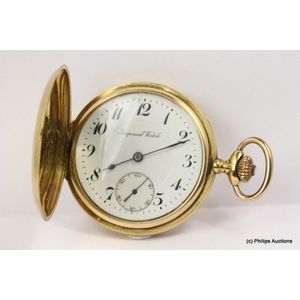18ct Gold Georgian Full Hunter Pocket Watch by James McCabe
You must be a subscriber, and be logged in to view price and dealer details.
Subscribe Now to view actual auction price for this item
When you subscribe, you have the option of setting the currency in which to display prices to $Au, $US, $NZ or Stg.
- Movement - The technical name for the workings of a clock or watch, and does not include the dial or case.
- Georgian - As an English stylistic period, Georgian is usually taken to cover the period from George I (1714) to the Regency of Prince George (1811-20), although the period from 1800 to 1830 is sometimes designated as the Regency period. During the Georgian period the great English cabinetmakers and designers such as Chippendale, Hepplewhite, Adam Sheraton etc., were all active.
Therefore there isn't a single 'Georgian style' as such and to say something is 'Georgian', usually means it was made between 1714 and 1830. This assumes we discount George V and George VI, both being from the 20th century.
The styles popular at the time of each reign were:
George I (1714-1727) saw out the last years of the Baroque period.
George II (1727-1760) reigned during the Rococo period.
George III (1760-1820) saw the last gasp of the Rococo, all of the early Neo-Classic 'Adam style' and most of the later neo-Classic 'Regency style'.
George IV (Prince Regent 1820-1830)encompassed the last of the 'Regency' style.
William IV's reign (1830-1837) was something of a no man's land (stylistically) and he wasn't a 'George' anyway. He covered the last glimmerings of 'Regency' and the start of the 'Victorian' style. - Fusee - The fusee movement was used in clocks and pocket watches from the mid 17th century. The fusee is a cone shaped drum within the works that is linked to the barrel of the spring, usually by a length of chain.
As the mainspring loses its tension over time, the cone shaped barrel compensates for this by increasing the tension, by pulling the mainspring tighter, thus ensuring the time remains constant.
Use of the fusee in clocks was superseded by the "going barrel" in the mid 19th century and for pocket watches at the beginning of the 19th century.
The fusee continued to be used in marine chronometers until the 1970s.
This item has been included into following indexes:
Visually similar items

A gold split second chronograph pocket by Baune, 18ct yellow gold, movement marked Baune 34029, Swiss case with London import mark 1907 Ab 18ct 132065 Swiss movement split second chronograph, plain polished case, white enamel dial, crown wind, total weight

9ct gold Waltham full hunter pocket watch working when tested, presented on retirement from Metro Guards Section 13-8-16

A gold quarter repeater chronograph full hunter pocket, 14ct rose gold, case hallmarked 14K 9856 Les Fils De R. Picard, Chaux De Fonds. Movement unmarked quarter repeater chronograph, crown wind, total weight: 93.5 grams

A gold slim cased full hunter engine turned case, crown Wind.18ct yellow gold, dial marked Imperial Watch, Case hallmarked 750/18K 886040 Imperial 15 jewels. Movement unmarked. Total weight: 81.7 grams
